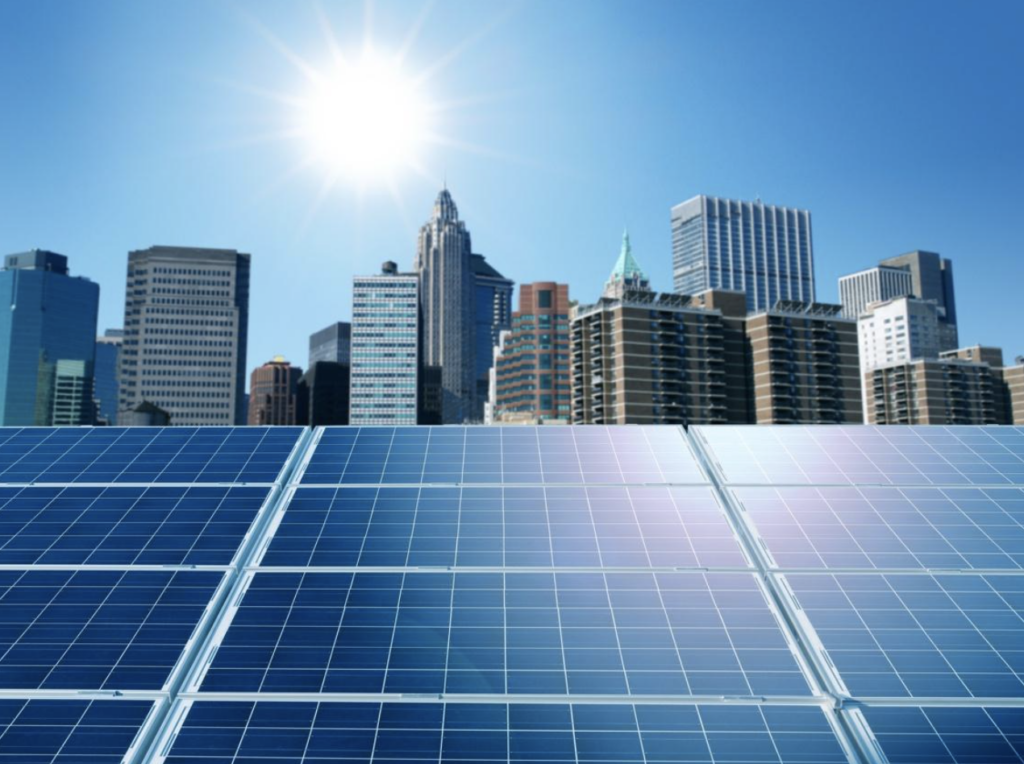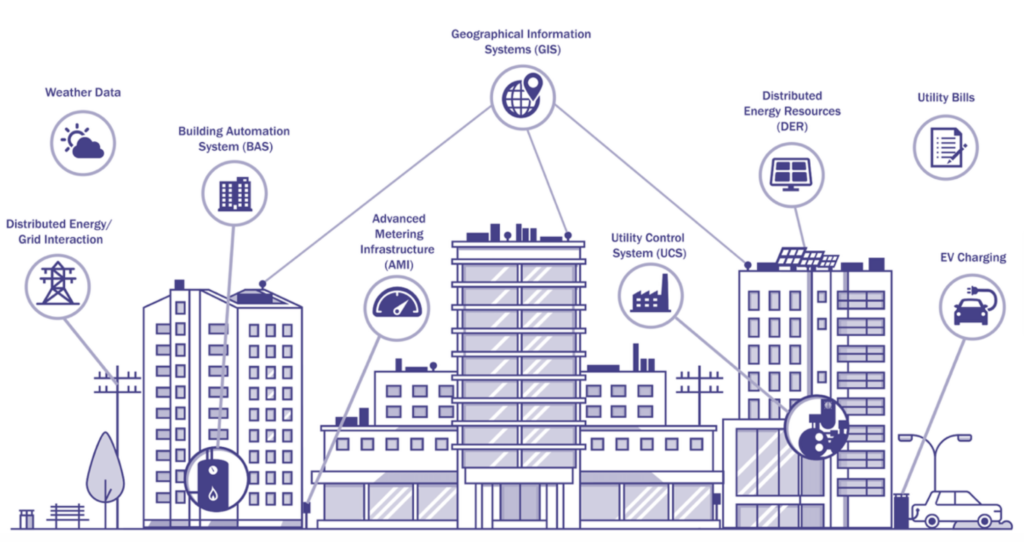Blog
What is a Virtual Power Plant (VPP)?
October 31, 2024
Virtual power plants (VPP) could save US utilities $10 billion in annual grid modernization costs. In addition, they can deliver millions of dollars in new revenue streams to behind-the-meter electric consumers. To date, most of these grid-edge VPP programs have been residential. But across the country, policymakers are setting a new trajectory for VPPs in commercial buildings. These buildings are by far the largest single contributor to greenhouse gas emissions. The commercial building sector is like a “sleeping giant.” It’s waking up to the enormous energy cost-saving and additional revenue opportunities resulting from participation in VPPs and grid integration programs.
In Connecticut, the Public Utility Regulatory Authority (PURA) created Innovative Energy Solutions (IES). This statewide initiative seeks to identify pilots that enable a decarbonized and affordable electric. In Cycle 1 of the PURA program, $1.4 million was allocated to develop a VPP with up to 25 commercial customers located in distressed municipalities in Connecticut. Edo was selected to spearhead this building-to-grid virtual power plant initiative.

What Are VPPs?
Virtual Power Plants (VPPs) have become a popular term in the energy industry. However, it’s crucial to establish a clear definition to ensure alignment.
VPPs are the aggregation of distributed energy resources (DERs) and building loads, working together to balance energy supply and demand on the grid, much like a traditional power plant.
In commercial buildings, this may include rooftop solar with batteries, EVs and chargers, and HVAC and lighting loads.
However, the operation of today’s VPPs is different from that of traditional power generation. Rather than relying on a single, centralized facility, modern VPPs utilize a cloud-based platform that enables real-time monitoring and control of distributed resources. This allows for real-time optimization of energy production and consumption across multiple sites. For commercial buildings, this means the opportunity to transition from passive energy consumers to active participants in grid stability while potentially generatingadditional revenue streams.
The Evolution of VPPs
VPPs have their roots in demand response (DR) programs, which utilities have implemented for the past 30 to 40 years. The evolution from traditional DR to modern VPPs is best explained in distinct phases. The first phase, often referred to as DR 1.0, initially focused on basic load curtailment programs. These programs required large energy users to manually reduce their consumption during peak demand periods, often with limited effectiveness and participation.
The next phase, Demand Response (DR) 2.0, introduced automated controls and two-way communication, enabling more dynamic and responsive load management. Automated DR eliminated the need for building operators to manually curtail equipment during events, reducing operational barriers. However, the duration of these events remained tied to emergency grid needs, averaging around four events per year.
Phase 3, or DR 3.0, marks the integration of distributed energy resources (DERs) and advanced analytics in commercial buildings. This enables daily scheduling and dispatching to provide both injection and curtailment of energy in response to grid signals. In this phase, AI-enabled VPPs function as a flexible and versatile energy resource. They are capable of both generating and sharing power for real-time grid optimization and market participation. As mentioned earlier, Edo’s building-to-grid modelis advancing this concept in Connecticut.
How Do Commercial Building Virtual Power Plants Work?

To grasp the transformative potential of virtual power plants in the context of commercial buildings, it’s essential to understand how they operate. At their core, VPPs function as intelligent networks of distributed energy resources (DERs) and buildings. They continuously balance energy supply and demand from the feeder level to the broader service territory. VPPs respond to utility signals from their Distributed Energy Resource Management System (DERMs) or Advanced Distribution Management System (ADMS). Advanced metering infrastructure (AMI) provides real-time data on energy consumption and production. At the same time, building automation systems enable precise control of various loads.
Commercial buildings often possess underutilized resources and loads that can be effectively harnessed within a virtual power plant.
The Aggregation Process
Resources & Loads in Commercial Buildings
- HVAC Systems: Representing a substantial portion of energy consumption, HVAC systems can be controlled to reduce load during peak demand periods without compromising occupant comfort.
- Energy Storage: Battery systems and thermal storage can be utilized to store energy during low-demand periods and discharge it during peak demand.
- Electric Vehicle Charging Stations: Utilizing EV chargers as flexible load resources to support grid load, particularly if combined with battery storage to manage charging times.
The strength of VPPs lies in their ability to aggregate diverse distributed energy resources (DERs), which allows for greater flexibility and scalability in balancing grid supply and demand. The VPP’s primary task is to orchestrate these elements, optimizing their operation to meet grid needs while maximizing benefits for participants.
Consider, for instance, a typical weekday afternoon in a commercial district. As solar production peaks and office energy demand rises, the virtual power plant might direct excess solar energy from one building to charge the batteries in another, preparing for the evening demand spike. Simultaneously, it could also adjust the cooling systems across multiple buildings, subtly altering temperatures to reduce overall energy consumption without compromising comfort. Another exampleis during unplanned demand response events or grid emergencies, grid operators can mobilize VPP resources to provide thenecessary capacity.
VPPs may also inject power with battery energy storage systems. This rapid response capability is critical in maintaining grid stability and requires sophisticated forecasting and real-time decision-making. VPPs must predict not only grid-wide demand but also the potential output of each connected resource. Weather forecasts, historical usage patterns, and even factors like local events or holidays all feed into these predictions.
The Critical Role of Software and Algorithms in VPPs
The brains of a virtual power plant operation are predictive models. Traditional utility management systems like Advanced Distribution Management Systems (ADMS), Distributed Energy Resource Management Systems (DERMS), and Supervisory Control and Data Acquisition (SCADA) systems provide a foundation. However, these systems do not extend to behind the meter. This is where advanced VPP software solutions come into play. These platforms leverage AI and machine learning algorithms to process vast amounts of data in real-time, making split-second decisions that optimize VPP performance. The American Council for an Energy-Efficient Economy (ACEEE)states VPPs are the key to providing granular, real-time data to both utilities and their customers.
These AI models analyze historical data, real-time inputs, and external factors to forecast energy production, consumption, and grid conditions. For example, a predictive model might anticipate a surge in air conditioning use based on a heatwave forecast, allowing the virtual power plant to preemptively adjust its resources. VPPs continuously ingest and process data from thousands of endpoints – from smart meters in commercial buildings to weather stations and grid sensors. This data flood must be analyzed instantly to inform operational decisions. In many regions, VPPs can participate in wholesale energy markets, capacity markets, and ancillary services markets. The software must navigate these complex market dynamicsandoptimize participation across these markets, considering factors like price signals, contractual obligations, and resource availability.
Proof of Concept
An April study of Virtual Power Potential in California concluded thatVPPs could create consumer savings of $550 million annually in California by 2035. Utilities like San Diego Gas & Electric have been developing interactive residential grid participation, aggregating various DER energy sources. These include rooftop solar panels, battery storage systems, and electric vehicle charging platforms. In August 2024,the state passed the Power Up California Act. The Act will incentivize PG&E and other utilities to interactively connect their growing number of customers to the grid.
In Oregon, during the July 2024 heatwave Portland General Electric (PGE), reduced daily peak demand by nearly 109 megawatts (MW) utilizing VPP technology. It lowered 100 MW over a 2-day period; enough electricity to power over 90,000 homes for a four-hour period. This was only the second time in the company’s history that PGE activated its entire portfolio of energy-shifting programs.
Edo Provides Virtual Power Plant solutions.
Edo Virtual Power Plant Solutions
The benefits of VPPs in today’s energy sector are numerous and impactful. The World Energy Council Trilemma Index is a tool developed over 15 years ago. It analyzes the progress of the energy sector’s transition to reliability, affordability, and decarbonization. It will play a crucial role in virtual power plants (VPPs). In terms of reliability, VPPs contribute to improved metrics. These include the Customer Average Interruption Duration Index (CAIDI) and the Customer Average Interruption Frequency Index (CAIFI). These improvements are particularly beneficial for vulnerable communities that often experience more frequent and prolonged outages. By providing a distributed network of resources, VPPs enhance grid resilience. This ensures that if one part of the system encounters issues, other resources can compensate, maintaining a stable supply of power.
Regarding affordability, by optimizing energy use and facilitating participation in energy markets, VPPs can help reduce costs for both utilities and consumers. Experts are saying virtual power plants can be 40 to 60 percent more cost-effective than traditional peaker plants. They can offer more efficient delivery of electricity to consumers.
And finally, VPPs play an essential role in the pressing issue of decarbonization. Studies show VPP will reduce greenhouse gas emissions. The higher penetration of renewable energy reduces reliance on fossil fuel-based generation. Studies show that virtual power plant demand flexibility technologies could reduce electricity consumption by 742 terawatt hours (TWh) annually in the US by 2030. That number rises to 181 gigawatt (GW) during US summer peak demand. Notably, the DOE Pathway to Commercial Liftoff urges creating a sustainable energy system. It also challenges energy stakeholders, public and private, to accelerate thedeployment of VPPs.
About Edo
Edo is leading this charge as a leading provider of innovative energy efficiency and demand flexibility solutions. We partner with utilities to transform commercial buildings into efficient, reliable contributors to the electric grid. Utilities rely on Edo’s virtual power plants and AI-driven technology to optimize thousands of buildings and aggregate distributed energy resources. Edo’s technology and expertise decrease energy consumption, reduce costs, and cut carbon emissions for a sustainable future.
News + Insights

Edo and EPRI Earn Award from the California Energy Commission (CEC) to Advance VPPs in Schools
LOS ANGELES, CA, UNITED STATES, October 2024 —Edo, a leading provider of demand flexibility solutions, is proud to announce it…

Edo Wins Grid Innovation Pitch Competition at GridFWD 2024
SEATTLE, WA, UNITED STATES, October 2024 — Edo, a leader in energy efficiency and demand flexibility solutions, proudly announces it…

Eight Minutes Podcast: VPPs and Commercial Buildings as Grid Assets
Edo co-founder, Courtney Blodgett, recently sat down with Paul Schuster for the Eight Minutes to discuss how Virtual Power Plants (V…